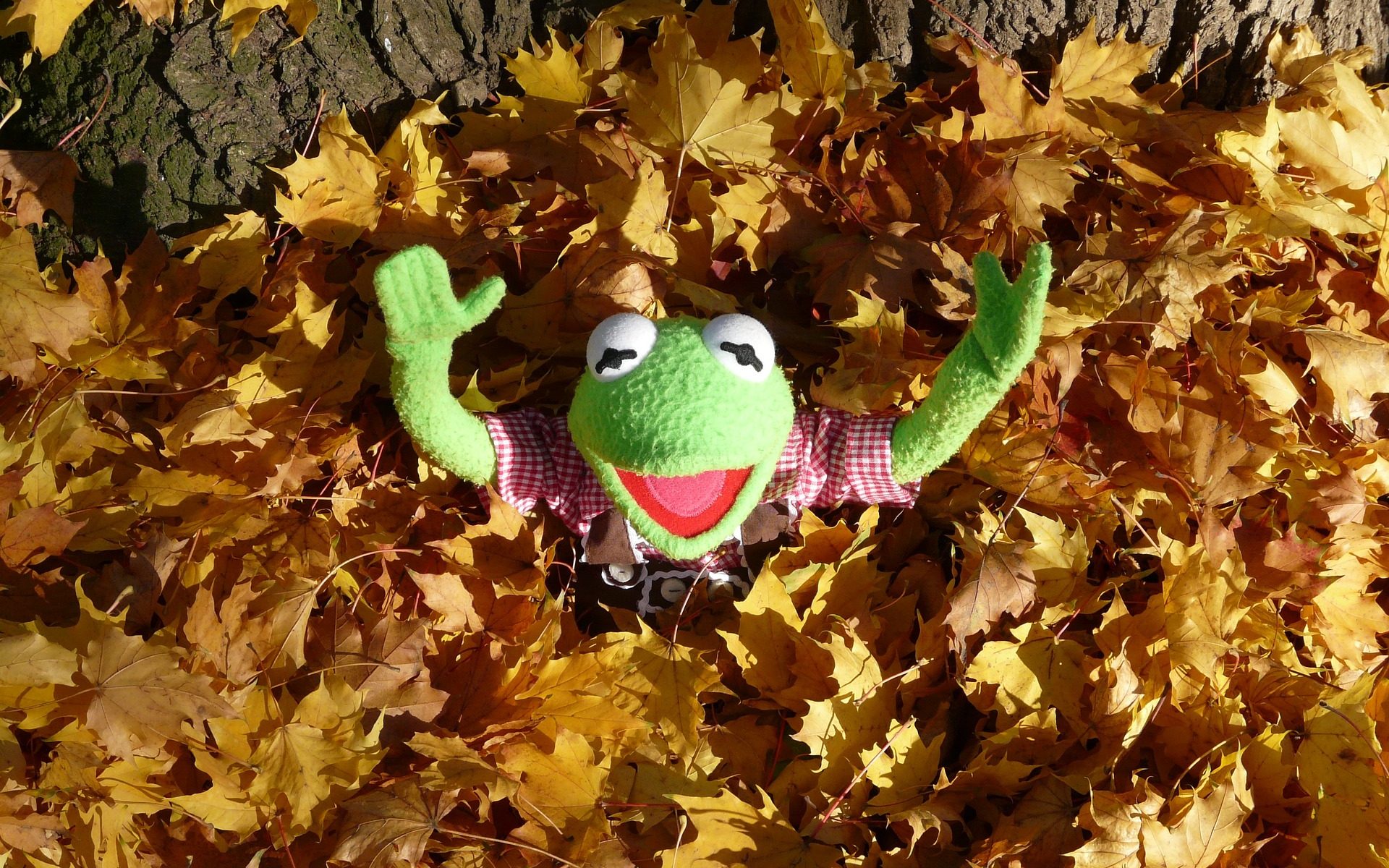“A little nonsense now and then is cherished by the wisest men.”
-Roald Dahl
October Tidings Friends!
This time of year – with the leaves falling all over the ground – always makes me think about the quintessential childhood activity of raking up a giant pile of leaves in the yard just to jump in it.
To the adults, it’s a great way to get those pesky leaves gathered up so they can be more efficiently bagged. But to the kids, the sole purpose is: play.
But how many of us grow up and still see the playful possibilities in the piles of leaves all over our yard?
This past weekend in Minnesota it was a beautiful fall day and I was outside watering my new landscaping. While accomplishing my useful adult task, I was also watching four little kids across the street playing in their yard.
I couldn’t tell you what they were doing – some version of yoga/martial arts/dragging each other across the grass?
But that’s the point – as children we don’t need to define what playing is, we just go outside, let our imaginations take over, and get weird with it.
But, somewhere along the way, it seems we stop knowing how to get weird with it.
I was 8 years old when I first consciously discovered stress, expectations, being responsible, and having to choose between work and play.
I remember it clearly.
My 3rd grade teacher always gave us copious amount of homework, and being as thorough and meticulous as I was, I could never seem to get it all done.
I’d be inside working away for hours, listening to the rest of the neighborhood kids playing outside and squealing with delight.
Thankfully my mom saw this problem and came to my rescue.
She started sending me to school with notes for my teacher: “Dear Mrs. So and So, Angela did not finish her homework because she worked on it for this many hours and then I sent her outside to play.”
Was it just me?
Even decades later with much consciousness around not letting my perfectionist tendencies get out of hand, I am still thorough, meticulous, and think about things deeply, which can be great qualities but also tends to translate into being slooow at finishing things.
Last year a relationship coach that the hubs and I were working with gave us intake paperwork that he said should take about 45min. It took the hubs exactly 45min and it took me three hours. So there’s that.
Or – was it just my early initiation into a culture where we will spend the rest of our lives choosing between work and play?
We all know the common proverb: All work and no play makes Jack a dull boy.

So then why does our culture put such a high value on work, forcing us so often to choose between work and play?
In the one-on-one coaching work I provide, we’ll often come up with assignments based around these six pillars: Gratitude, Quiet, Nature, Intuition, Self-Care, and Play.
And play…seems to be the hardest assignment for people!
It seems that as adults, we’ve almost completely forgotten what it really means to play.
Childhood: Keepin’ it Weird 🤸
I recently came across some photos of one of many notebooks from my childhood that contained some of my “to-do” lists.
For research purposes, I’d like to take you on a little journey into the mind of a – very detail-oriented – child as we try to remember once again the meaning of “play.”
Exhibit A from my childhood notebook:
“List of What We Can Do”

- Play outside or inside
- Play Pony’s
- Play Barbies
- Dress up and put makeup on and go to a place
- Have babies and play house
- Play game inside or outside
- Play on swing set
- Play on beach
- Roll down the hill
- Have a nature walk
- Play fashion girls
- Play store
- Have a play
What I love about this particular “to-do” list is that it’s really just 13 different ways to play!
Exhibit B from my childhood notebook:
“Things to do at the Sleepover”
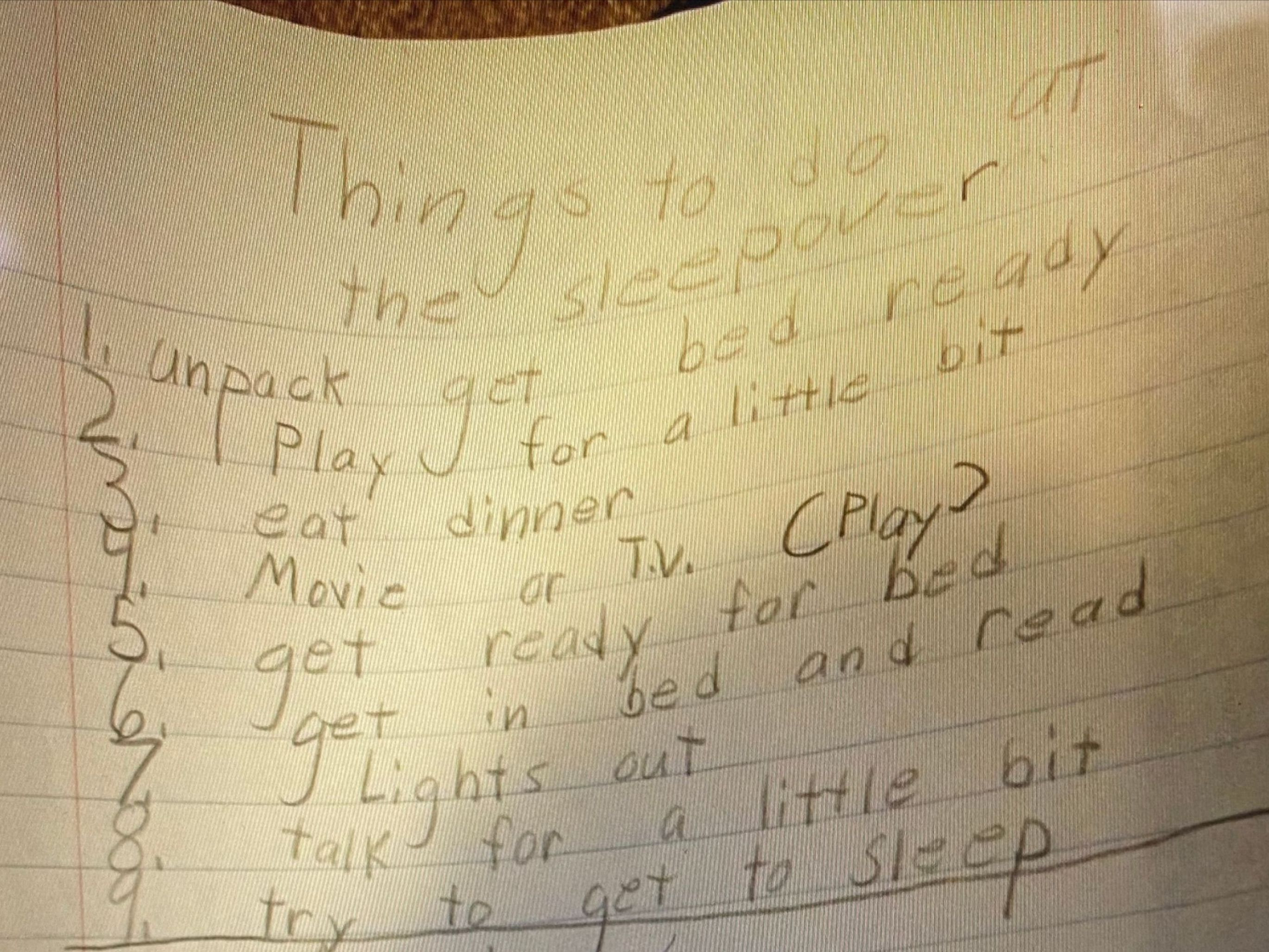
- Unpack and get bed ready
- Play for a little bit
- Eat dinner
- Movie or T.V. (Play)
- Get ready for bed
- Get in bed and read
- Lights out
- Talk for a little bit
- Try to get to sleep
You may have noticed that this sleepover itinerary (the detailed itinerary is standard sleepover practice, right?) contains not one, but TWO instances of play.
Exhibit C from my childhood notebook:
“Morning”

- Watch TV
- Eat breakfast
- Get dressed
- The rest of the day, plan what we are going to do while the day is going.
That last one seems to be my hyper-organized child-brain interpretation of the idea: just be spontaneous. Which also feels like a roundabout way of trying to say: play!
Thanks to my childhood propensity for list-making, we can see that the importance of play is so CLEAR to us as children.
Even to very organized, detail-oriented children, play makes the list again and again.
So, the question is, can we remember once again as adults what it means to play?
What is Play? 🤸
So, let’s go back to the beginning.
What exactly IS play?
The dictionary defines play as: activity engaged in for enjoyment and recreation – rather than a serious or practical purpose – especially by children.
But we’re about to change that “especially by children” part because my goal by the end of this is to get you and your adult brain re-excited about the idea of play.
Some other ways we might define play are: amusement, entertainment, recreation, enjoyment, pleasure, diversion, leisure, fun, games, horseplay, revelry, living it up – and my personal favorites, jollification and merrymaking.
We can go play, or we can: have fun, have a good time, amuse oneself, enjoy oneself, be at leisure, frolic, or romp.
Have you frolicked or romped lately?
And the definition of play lists the opposite of play as – you guessed it, work.
But it’s interesting to note that Dr. Stuart Brown – psychiatrist, pioneering play researcher, and founder of the National Institute for Play – says that the opposite of play isn’t work, it’s depression.
All work and no play makes Jack a dull boy…because Jack is now depressed.
Far from frivolous or just for children, we can see that play is a super foundational aspect of our very wellbeing!
Dr. Brown also defines play as something done for its own sake; it doesn’t have a particular purpose. He says that if the purpose is more important than the act of doing it, it’s probably not play.
I think this is where we get into trouble as adults.
It’s hard to convince ourselves to engage in something that has no purpose!
Just the other day the hubs was telling me about some of his coworkers who are in a fantasy football league. They all put in a hundred dollars and someone wins the pot at the end.
I asked him what he thought their purpose was – was it to win the money or just for fun? Would they all still do it if there wasn’t any prospect of winning money and it was just for the pure enjoyment of it?
What about the things that you engage in – do you go running because you love running, or because it’s good for your health? Do you do crossword puzzles because you love crossword puzzles or because it promotes healthy brain function? Do you engage in fantasy football because it’s fun or because you could win a bunch of money?
When we’re truly playing, it’s about our love for the very thing we’re engaging in – regardless of what the outcome may be.
Of course it’s still ok to partake in those other outcome-driven activities, but it might be worth re-evaluating why we are doing the things we do, and if there are other things we might be more excited to spend our time doing – that might even result in the same outcome but with a much more enjoyable path to get there!
For instance, if you want to promote a healthy lifestyle – a worthy outcome – but you hate running, what if you found a different activity that you do love doing?
Something that feels like play and just happens to also support your health?
Imagine the joy if we organized our whole life this way!
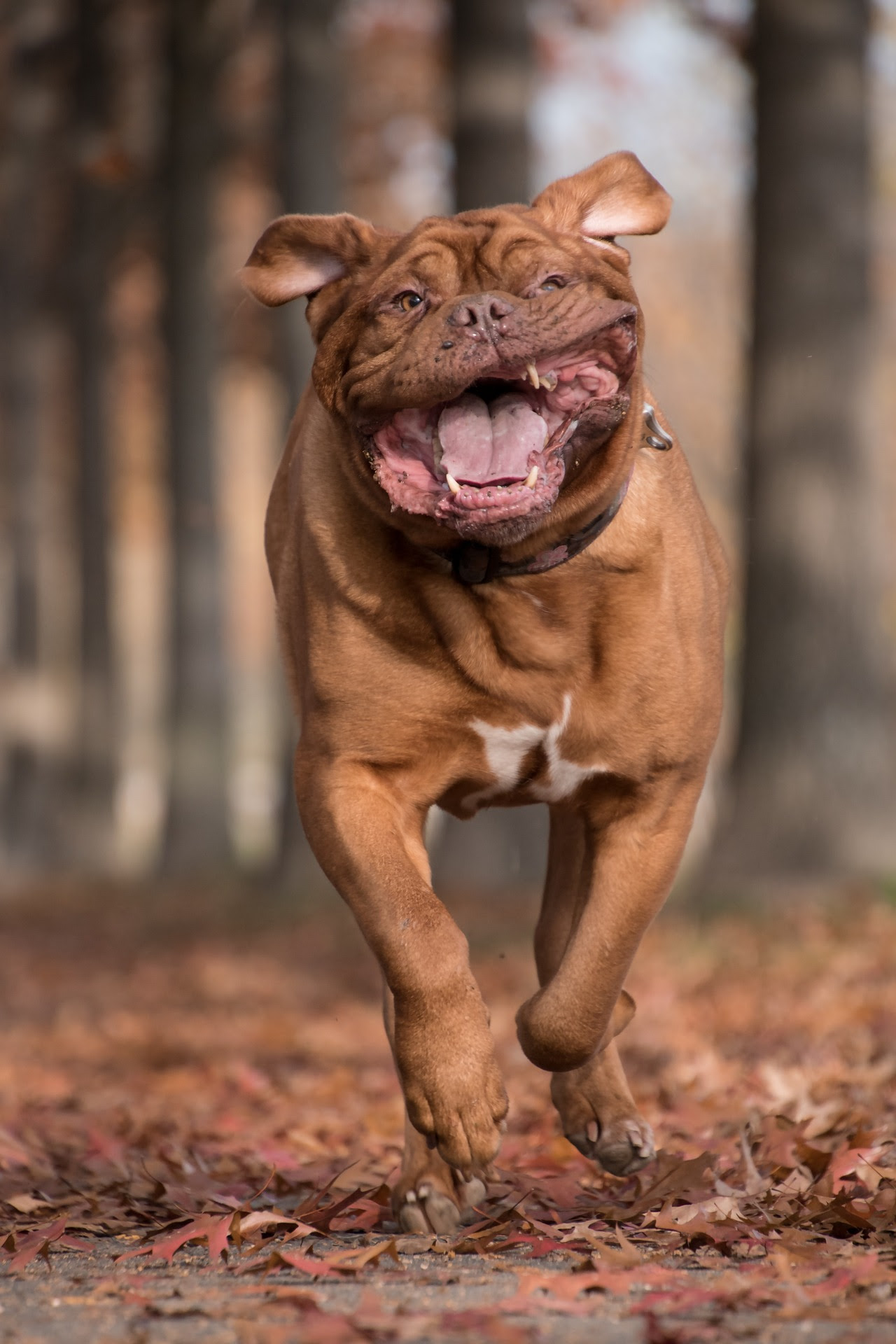
How Do We Play? 🤸
Ok so our adult brains are once again interested in playing…but how do we do that again?
Sure, we could roll down the hill or swing on a swing set, but most adults don’t want to “have babies and play house” because that’s just regular life.
So we can use my childhood lists for inspiration, but we might need to get a little more creative about what play looks like for us now!
Speaking of needing to get creative, let’s examine the very relationship between creativity and play.
Dr. Brown says that from a neuroscience perspective, “Nothing lights up the brain like play.”
Specifically – our right brain lights up when we are playing. Whereas the left brain is our more yang, masculine, logical, analytical side, it is the right brain that is our more yin, feminine, intuitive, creative side.
It makes sense that play, having no logical purpose or outcome, would be linked to our creative right brain.
But does it follow then, that if we’ve forgotten how to play, that we’ve also forgotten how to be creative?
And so if we allow ourselves once again to be creative, will we naturally remember how to play?
It seems that creativity and play support each other, need each other.
Creativity goes way beyond arts ‘n crafts. It is the driving force that allows us to create what has never been created before, to imagine what has never been done before.
Being creative improves our ability to solve novel problems; it means we’re better able to be adaptable to whatever life throws at us.
As Swiss psychiatrist Carl Jung has said: “The creation of something new is not accomplished by the intellect, but by the play instinct.”
And author and inventor Roger Von Oech has echoed: “Necessity may be the mother of invention, but play is certainly the father.”
In addition to this increased creativity, adaptability, and problem solving, studies on play have also shown that play releases feel-good endorphins, improves memory, and stimulates the growth of the cerebral cortex.
It helps us with stress management and even improves our relationships – laughing and having fun not only helps lighten our own burdens, but fosters empathy, compassion, trust and intimacy with others.
And although we’ve said that true play has no purpose, I think that’s a convincing enough list of desirable outcomes for our logical left brains to get on board!

Ok so right-brain creative juices flowing, left-brain motivation on board – let’s get to the how.
According to Dr. Brown, play isn’t just one thing – there are actually multiple categories that we might engage in:
Body play – physically engaging the body, or adrenaline-charged activities
Object play – building or manipulating objects
Social play – play with others
Rough and tumble play – physical play with others i.e. sports, wrestling around
Spectator play – watching sports, watching others play
Ritual play – contains rules and structure i.e. board games
Imaginative play – arts ‘n crafts, comedy, improv, storytelling
And, he says, we can even have one of eight different “play personalities!”
These are: The Collector, The Competitor, The Creator/Artist, The Director, The Explorer, The Joker, The Kinesthete, and the Storyteller.
For help determining your play personality, Dr. Brown goes into specifics on each of the types here: https://www.nifplay.org/what-
Knowing your unique play personality could help you come up with ideas for what play can look like in your adult life, but the most important thing is just paying attention to those activities that naturally excite and energize you.
One of the first questions I always ask someone when profiling for their psychological type – which is different from a play personality, but I definitely see some crossover! – is this: what do you love to do?
What are you doing when time just seems to fly by, when you look at your watch suddenly and realize three hours has passed and you forgot to eat or pee?
What is it you love to do so much that you would keep doing it endlessly and joyfully until you finally reach exhaustion?
Pay attention to all the details: when time flies by joyfully are you typically alone, or with others? Where are you, indoors or outdoors? And what is it that you’re engaging in?
Answer these questions for yourself and you might find some big clues as to how you prefer to play!
Play vs. Rest 🤸
It’s interesting to note that the definitions of play also included rest and relaxation in their lists of synonyms.
But I excluded these on purpose because I think it’s important to differentiate play from rest and relaxation.
Because although our child brains didn’t need any help defining the differences between work, play, and rest – I think our adult brains need to know!
As grownups with already too much to do on our plates, we might be tempted to smoosh play and rest into one singular category in order to best manage our seemingly limited resource of time.
And while play and rest might be dear cousins, they each definitely deserve a dedicated place on our plates!
We’ve already thoroughly defined play, so let’s take a gander into the meanings of rest and relaxation.
Rest (verb): to cease work or movement in order to relax, refresh oneself, or recover strength.
Relaxation (noun): the state of being free from tension and anxiety.
Synonyms: let up, slow down, pause, laze, idle, do nothing, unwind, recharge one’s batteries, take it easy; calm, tranquility, peacefulness, unwinding.
I would personally categorize both play and rest/relaxation as various manifestations of yin/being/non-doing energy. This is where they do share similarities.
But the difference I see between them is rest and relaxation are yin/being/non-doing energy turned inward – nourishing to the body, heart and soul – a more or less complete ceasing of activity.
We rest after we’ve worked hard; we also rest after we’ve played hard.

Whereas play is yin/being/non-doing energy directed outward – an expression of the body, heart, soul and spirit.
It’s active, but activity stemming from joy.
These both contrast with ‘doing’ energy that has more of a yang, mental, logical, rational, emotionally-detached, achievement-oriented energy. Typically, where we would categorize most work and tasks on our to-do lists.
Author Anita Moorjani in her book Dying to Be Me has a useful explanation of how to know when you’re in being vs. doing energy:
“When we live completely from the mind over a period of time, we lose touch with the infinite self, and then we begin to feel lost. This happens when we’re in ‘doing’ mode all the time, rather than ‘being.’ […]
‘Being’ doesn’t mean that we don’t do anything. It’s just that our actions stem from following our emotions and feelings while staying present in the moment.
Doing,’ on the other hand, is future focused, with the mind creating a series of tasks that take us from here to there in order to achieve a particular outcome, regardless of our current emotional state.
I have discovered that to determine whether my actions stem from ‘doing’ or ‘being,’ I only need to look at the emotion behind my everyday decisions. Is it fear, or is it passion?
If everything I do each day is driven by passion and a zest for living, then I’m ‘being,’ but if my actions are a result of fear, then I’m in ‘doing’ mode.”
Following this definition, play is the perfect example of actions that “stem from following our emotions and feelings while staying present in the moment.”
But we often already feel stretched about finding the time for rest and relaxation in our busy lives.
And we don’t want play to just feel like another thing we now have to take the time to do.
I’ve definitely heard that from clients before – and have been there myself, too. Our best healthy intentions and habits just end up as another task on the to-do list.
But what if we didn’t have to find a way to fit play into our already busy schedules, and instead could allow it to naturally seep into our everyday lives?
Play: Balancing Force or Driving Force? 🤸
Wouldn’t it be delightful to live our lives driven each day by ‘passion and a zest for living’ as Anita Moorjani says?
To do so, maybe we need to rethink the way we view play – as more than just a balancing force in our lives.
When I was in college, I found the level of work and stress really ramped up from the days of my third-grade woes. So, the level of play did too.
We all know the saying: work hard, play hard.
But what is real play? Is it letting off steam? A release valve for the pressure of our busy lives? Simply a way to balance out all the work and stress in our lives?
Modern living has created lives that clearly need some amount of carved out time for play in order to feel balanced – but what if play isn’t meant to simply be a balancing force?
If we need this release valve and balancing force so badly in our lives, what is going on with the rest of our lives? Why are we allowing the other half of our lives to reach such an intense level of stress?
Are we so bored or unhappy with this other half of our lives that we need to make up for it in equal doses of fun and excitement?
Is it even sustainable to keep ramping up the levels of work and play? For me, eventually it wasn’t and I burned out and got very sick.
But is that really what true play is? Just a release valve? Or is it something deeper, something much more vital to our wellbeing?
What if play wasn’t meant to be simply a balancing force for the out-of-whack other half of our lives, but the primary driving force that propels us forward through our whole lives?
How would our lives look – and more importantly feel – differently if we were driven by the force of play rather than the force of striving, pushing, or proving?
What if we still achieved great things, accomplished great feats, and showed the world our magic – but simply as the happy result of being driven by play?
We’ve found that play has a close relationship to creativity.
What about its relationship to joy?
If the opposite of play is depression, and we think of the opposite of depression as joy – I would say play and joy are definitely close cousins, maybe even siblings.
Striving, forcing, proving are descendants of fear – it doesn’t feel good to live our lives driven from this place.
Wouldn’t it feel better to be driven by joy?
Dr. Brown says that our passions and our inner drive have a close relationship to our unique mode of play – and that we can probably trace these drives back to our childhood play styles.
He suggests this thought experiment to begin to explore our personal play history and how we might carry forward the golden thread of play from childhood into our current lives:
“…explore backwards as far as you can go to the most clear, joyful, playful image that you have, whether it’s with a toy, on a birthday or on a vacation. And begin to build from the emotion of that into how that connects with your life now.
And you’ll find, you may change jobs – which has happened to a number of people when I’ve had them do this – in order to be more empowered through their play. Or you’ll be able to enrich your life by prioritizing it and paying attention to it.”
He goes on to say:
“I would encourage you all to engage not in the work-play differential – where you set aside time to play – but where your life becomes infused minute by minute, hour by hour, with body, object, social, fantasy, transformational kinds of play. And I think you’ll have a better and more empowered life.”
In this way, play becomes much more than something to do in our spare time.
It becomes something with the potential to completely rearrange and transform our life and infuse it with passion, zest, and joy.
Putting it into Action 🤸
As adults we tend to make lists of what we must DO.
A few months ago the hubs and I started a joint to-do list for all our various house and yard projects and tasks. The idea is that at the beginning of each month we assess the list, remove anything that has been completed or no longer feels relevant, and pick out a few projects for the upcoming month.
Then we can put the list away until the next month to keep it from feeling like the endless pile of tasks that home ownership can sometimes feel like.
But, more recently I realized that we needed a second kind of list to assess each month, as well.
The list of fun things to do.
I was getting all these ideas for fun things to do, but then stressing myself out because we weren’t doing them! So, we decided a monthly assessment of fun things to do would be useful as well.
Why shouldn’t we take our play lists just as seriously as we do our to-do lists? After all, we’ve discovered that play is essential to our happiness and wellbeing.
Young Angela showed us that a to-do list can certainly include not only one, but 13 ways to play.
So I challenge you to make your own list of fun ways to play, AND to take it as seriously as your to-do list!
And if you really want to revolutionize your life, start thinking about not only how you can add back in more ways to play, but how the very building blocks of your life can be fueled by what feels playful.
What if family activities felt like playtime not only for the kids, but the adults as well? What if date night felt like play? What if exercise felt like play? What if your very job felt like play??
Recently I’ve started playing around with activities that feel fun and joyful, like rollerskating and dance! It feels playful for my inner child and freeing for my adult self.
It also just happens to be a surprisingly good workout – although I have to be careful to remember that that’s not the point, just a happy accident – otherwise it’s easy for play activities to start to feel like just another task on the regular to-do list.
If that happens to you, try to tune back into the motives of your inner child: did you used to run all over the yard and jump up and down in a pile of leaves because it was a good workout and would sculpt your ass? Or because it was just really fun?
So that’s one way I’ve started adding back ways to play. But I also make sure to infuse my life with the very driving force of play.
Because I own my own business and have no one to blame but myself, anytime work starts to feel like…work…heavy, blah or uninspiring – I take it seriously and contemplate how I can mix things up again.
It’s a blessing and a curse to work for yourself, because you can do whatever you want AND you’re usually the one standing in your own way.
I have to come back to the idea of what feels joyful and playful A LOT so that I don’t get too hard on myself about what I’m not achieving yet or think I should be achieving now.
So that the process itself is still fun, regardless of the outcome.
So, now it’s your turn – go forth and PLAY, frolic and be merry!
And as you journey forward into your own playful life, you might find it inspiring to remember what playwright George Bernard Shaw has said:
“We don’t stop playing because we grow old; we grow old because we stop playing.”
💫🤸💫
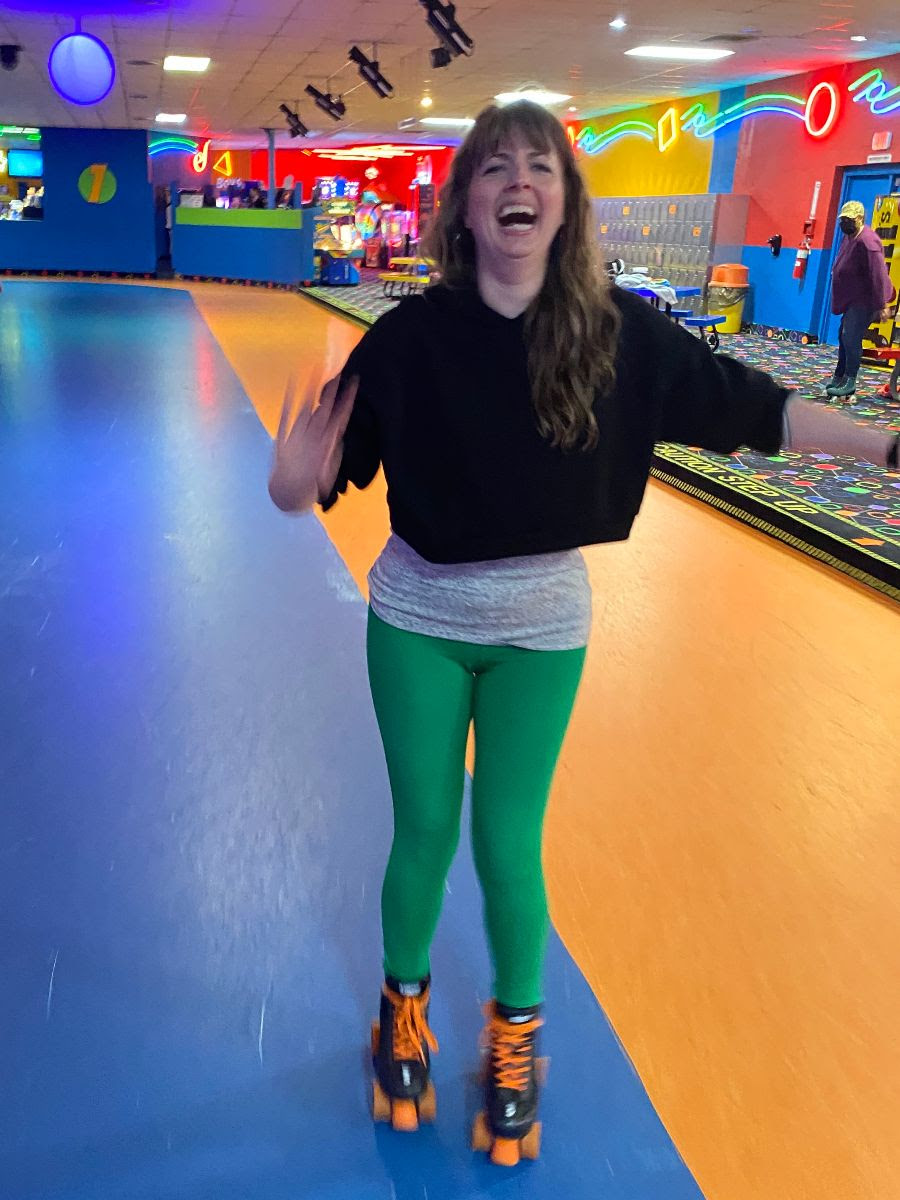

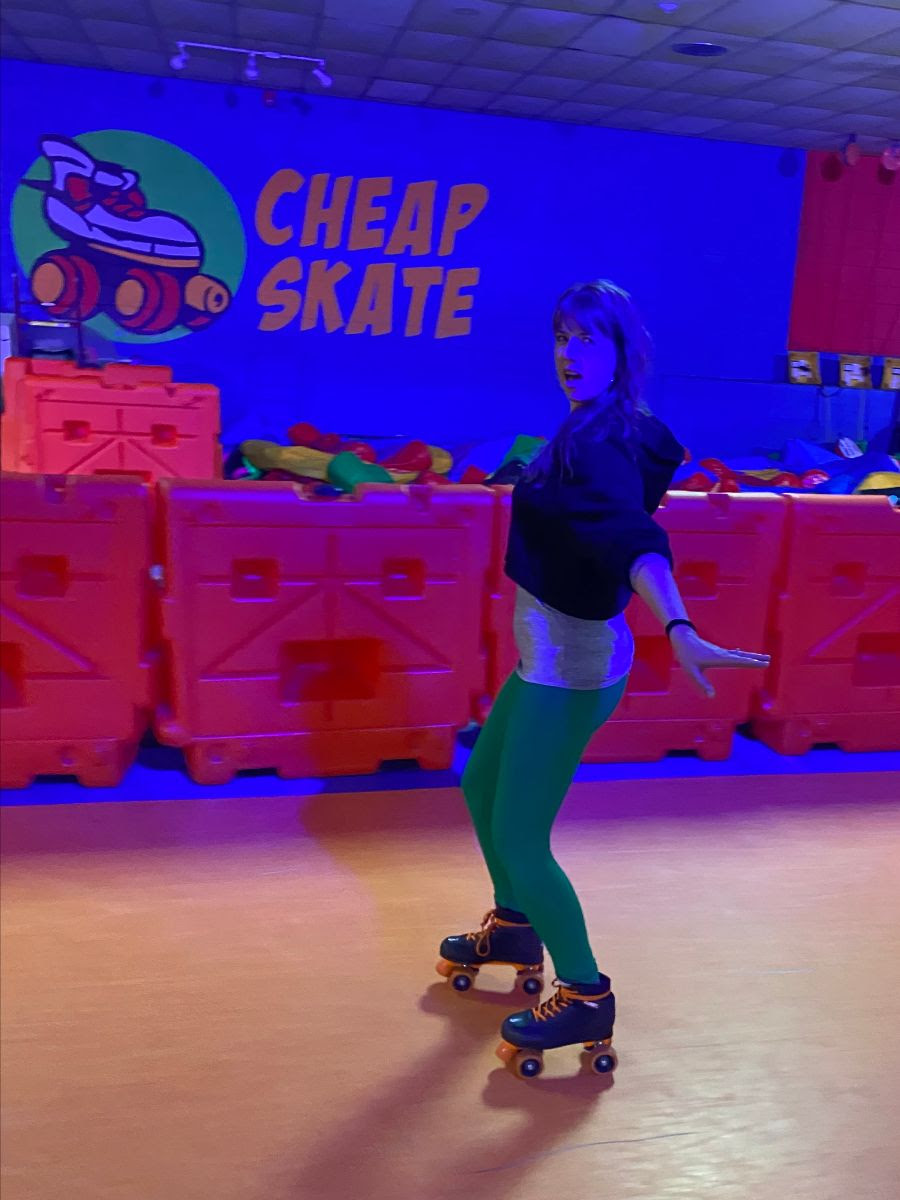
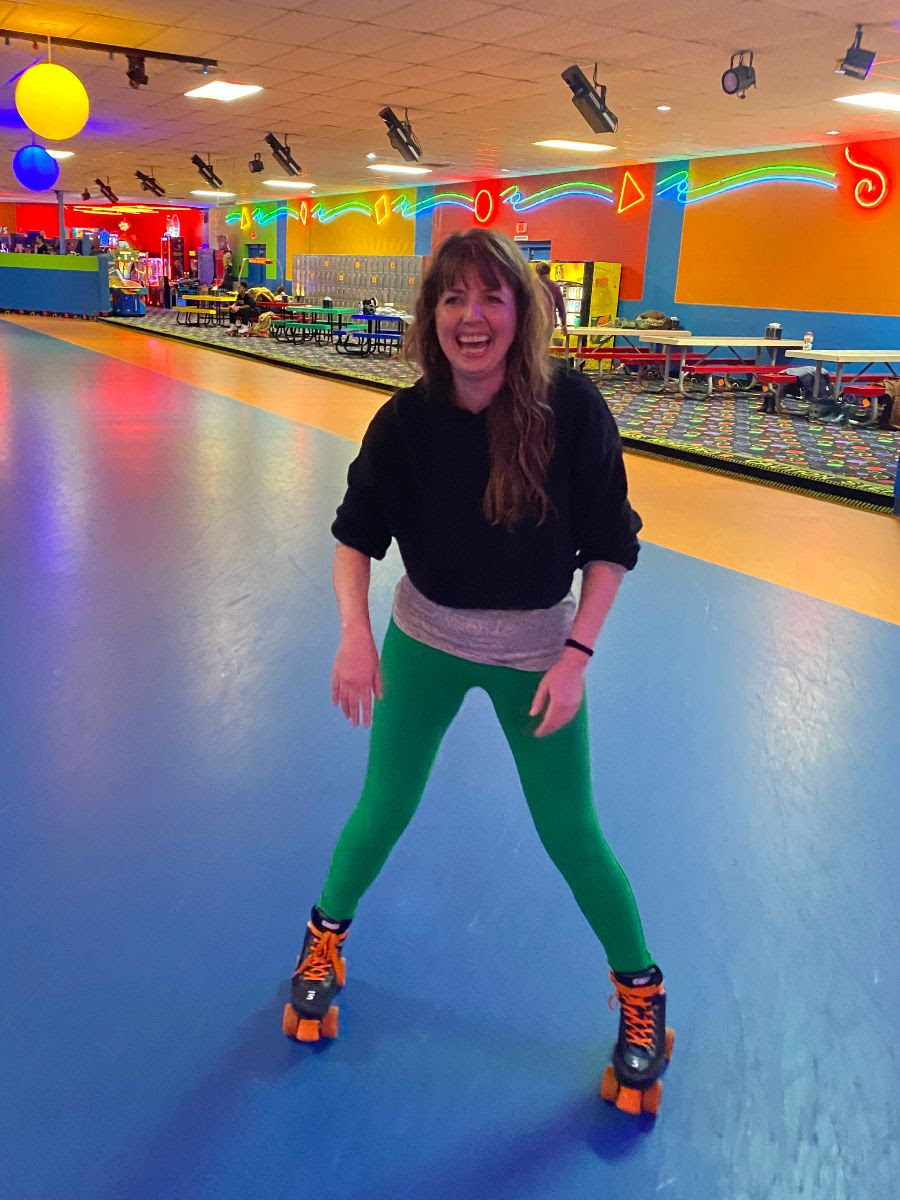
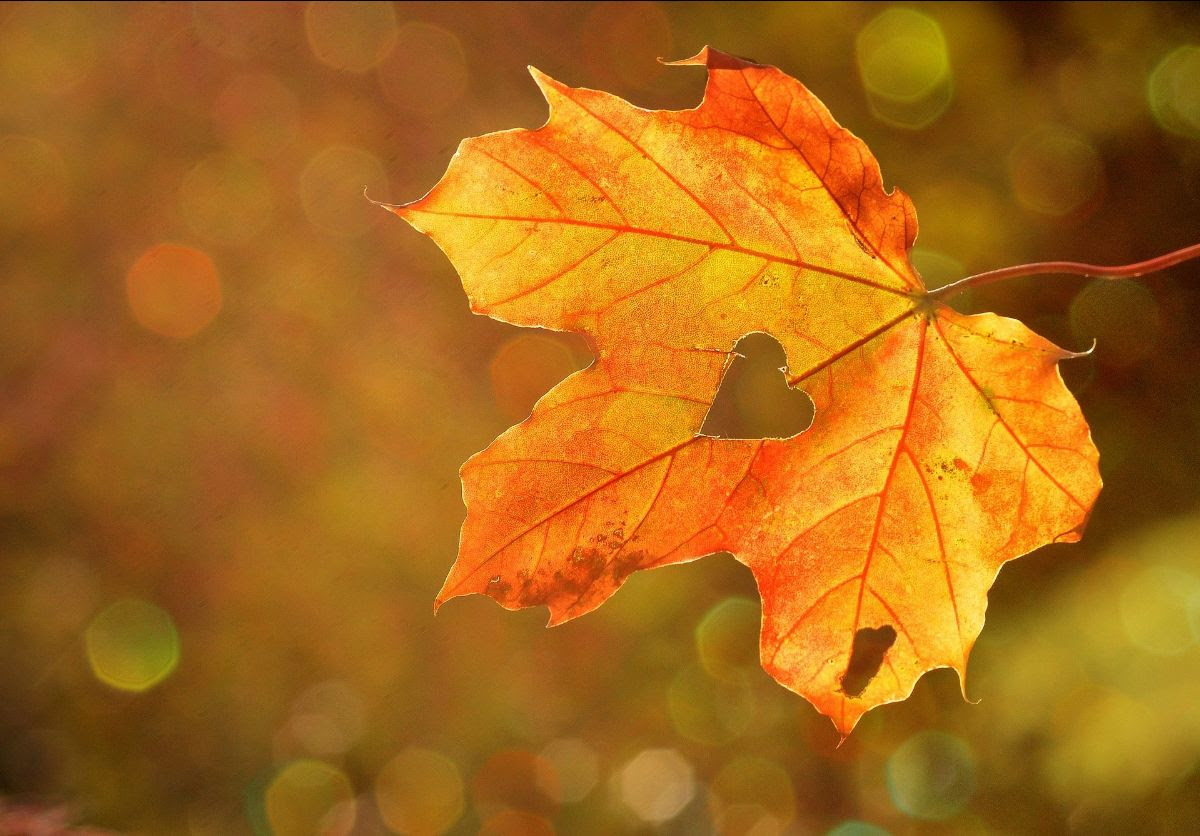 Happy late Autumn, friends!
Happy late Autumn, friends!
What’s on YOUR play to-do list? How will YOU infuse your life with play?
May you unleash your creative side, find JOY in playing once again, and have fun gettin’ weird with it.
Happy frolicking, romping and merrymaking!

